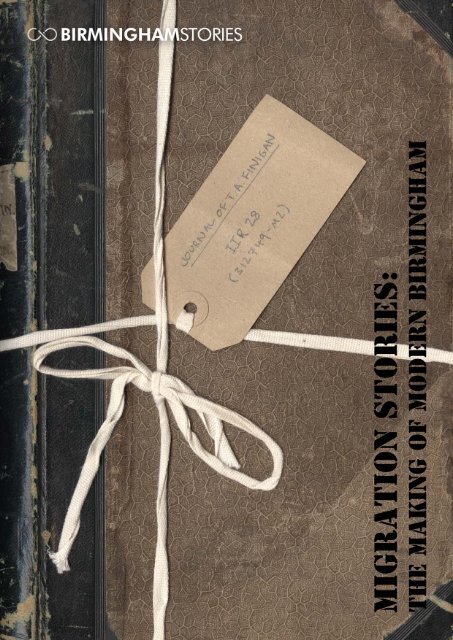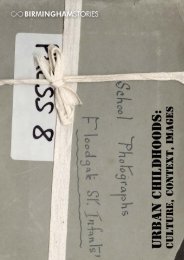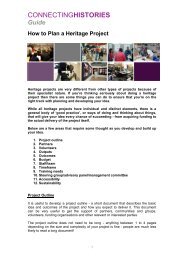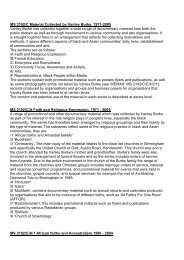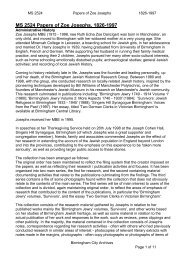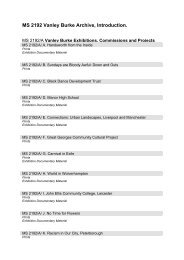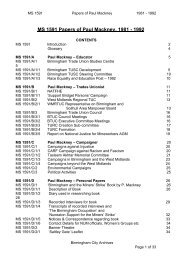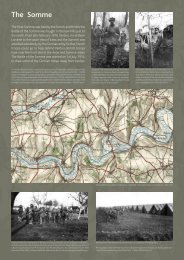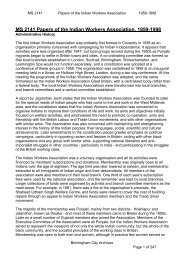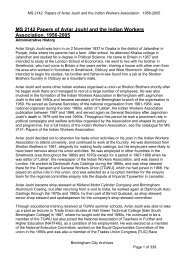Migration Stories - Connecting Histories
Migration Stories - Connecting Histories
Migration Stories - Connecting Histories
You also want an ePaper? Increase the reach of your titles
YUMPU automatically turns print PDFs into web optimized ePapers that Google loves.
<strong>Migration</strong> <strong>Stories</strong>: The Making of Modern Birmingham<br />
Contents<br />
Introduction: Whose History, Whose Heritage<br />
The Emergence of a Jewish Community<br />
Tracing Irish <strong>Histories</strong><br />
The Early Asian Presence<br />
Racism and Riots in the Early Twentieth Century<br />
Summary of Key Themes<br />
Sources from Birmingham Archives and Heritage Collections<br />
Secondary Reading<br />
Written by Dr Andy Green and Dr Kevin Searle, 2008.<br />
www.connectinghistories.org.uk/birminghamstories.asp
Ackermann’s panorama of Birmingham, 1847.<br />
The Illustrated Midland News, 1869.<br />
1774<br />
A Church of England parish record<br />
mentions the burial of a<br />
‘black bachelor,’ George Pitt Charry,<br />
St Martin’s, Birmingham. [DRO34/5]<br />
1778<br />
Jacoba Swellengrebel (died 1796)<br />
lived in Handsworth from about 1778.<br />
Her father was Dutch and her mother<br />
was Indian. Her husband was a<br />
relative of Matthew Boulton’s partner,<br />
John Fothergill. [MS3782]<br />
1790<br />
Letter by Olaudah Equiano, expressing<br />
‘grateful Acknowledgments’ to the<br />
town. [Aris’s Birmingham Gazette]<br />
1821<br />
Baptism in of Levi Baldwin, born 1770,<br />
North America, a musician and<br />
‘man of colour’, St Martin’s. [DRO34/12]<br />
<strong>Migration</strong> <strong>Stories</strong>:<br />
The Making of Modern Birmingham<br />
A church warden pays for a<br />
‘poore man comeing oute of Arabia’ to gain<br />
passage back to his ‘owne countrey’ in 1734<br />
[Sutton Coldfield Borough 78/111]<br />
Whose History, Whose Heritage<br />
The subject of migration has always had an important<br />
presence in Birmingham’s history. <strong>Migration</strong> stories in the<br />
West Midlands long predate the narratives of the settlers<br />
who came to live in the region in the post-war period. City<br />
archives identify that the black presence has been part of<br />
Birmingham for hundreds of years. These stories demonstrate<br />
that many of the issues that surround migration today were<br />
also pertinent in earlier periods. The repatriation of an Arabian<br />
man in 1734, and the deportation of ‘failed asylum seekers’<br />
and refugees in the present, arguably provides one such<br />
link.<br />
The following pages introduce the reader to a range of<br />
migration stories which have contributed to the making of<br />
modern Birmingham. Evidence of the first Asian, Irish, Jewish<br />
and black migrants in Birmingham allow us to broaden a<br />
sense of shared histories. They also allow us to ask to what<br />
extent are the debates about migration and settlement in<br />
the past linked to present concerns about identity, race,<br />
class and gender
<strong>Migration</strong> <strong>Stories</strong>:<br />
The Emergence of a Jewish Community<br />
First Migrants<br />
Leading up to the industrial revolution, Birmingham<br />
started drawing in people from the surrounding<br />
countryside to find work in a range of local trades:<br />
from buttons and buckles in the eighteenth century<br />
to iron and brass in the nineteenth century. Among<br />
the varied people who sought employment and<br />
lodgings, Jewish migrants also arrived from Europe<br />
and Russia, often seeking to escape social persecution<br />
because of their faith.<br />
Singer’s Hill Synagogue, 1861. [The Illustrated Midland News]<br />
A History of The Jewish Community<br />
of Birmingham (1956) states<br />
‘the generally agreed date of our<br />
first community is 1730’.<br />
Integration and Conflict<br />
Despite facing many social barriers, Jews in nineteenth<br />
century Birmingham would play an important<br />
role in developing key local industrial and jewellery<br />
trades. Gaining civic acceptance, the Birmingham<br />
Hebrew Congregation archive shows a community<br />
which organised, educated and provided for itself.<br />
However, with many new Eastern European arrivals<br />
to Birmingham into the late nineteenth century,<br />
fears over the Jewish culture carried over into the<br />
twentieth century.<br />
Levy Book of Birmingham, 1750.<br />
Building Synagogues<br />
William Hutton’s ‘A History of Birmingham’ (1780)<br />
suggests that the first synagogue in Birmingham<br />
was located in an area called the ‘froggary’ (now<br />
lies beneath New Street Station). More would be<br />
built as the community grew, often being attacked<br />
and vandalized in times of social unrest. In response,<br />
many Jewish migrants often lived in shared space<br />
as a way of protecting and reasserting their faith, in<br />
a country which often regarded them as ‘heathen’<br />
or ‘alien’. In 1856, the community built Singer’s Hill<br />
synagogue (still standing today), designed to hold<br />
1,400. It was an important symbol of cultural pride.<br />
Birmingham Trade Directory, 1775. [Trade Directories]<br />
Key Debate:<br />
what other sources of information<br />
could we use to find out more about the early Jewish Community of Birmingham
<strong>Migration</strong> <strong>Stories</strong>:<br />
Thomas Finigan, an Irish Town Missionary<br />
Early Voices<br />
Using archival evidence we can glimpse the Irish presence<br />
in eighteenth century Birmingham. The ‘Memoirs’ of<br />
William Hutton include the description: ‘March 1742.<br />
Thomas Buften () remarked, it was his birthday, and that<br />
he was 46; a sensible Irishman, and like many of his<br />
countrymen, (he) spoke with great elocution, and like<br />
them, rather given to the wonderful.’<br />
Nineteenth Century Struggles<br />
Hutton’s description contrasts with how the Irish were<br />
routinely viewed as ‘backward’ and ‘inferior’. By the<br />
nineteenth century, Irish migrants became caught up in<br />
destructive cycles of poverty and industrialisation rooted<br />
in a long history of exploitation by the English. With a<br />
series of famines that reached a peak with the ‘great<br />
hunger’ of 1845 to 1849, one and a half million people<br />
died of poverty and ill health, forcing a further million<br />
to emigrate abroad.<br />
Punch Magazine, 1881.<br />
Powerful evidence of the conditions facing Irish people<br />
arriving in Birmingham can be found in the journal of<br />
Thomas Finigan, who worked as a town missionary in<br />
1837. His account of Birmingham paints a vivid picture of<br />
the poverty, overcrowding, disease and unemployment<br />
facing working class people from different backgrounds.<br />
“I went to the Gullet again -<br />
I find as many openings - dark passages<br />
back courts in this Gullet, as probably there is<br />
in the Gullet of a Shark. In one of these I<br />
entered a house - I saw six females<br />
at card playing, and all of them<br />
almost in a statue of nudity - Oh!<br />
How serious, and how responsible is the work<br />
of a town missionary”<br />
In many cases, Birmingham’s nineteenth century urban<br />
problems were unfairly associated with Irish settlers. This<br />
issue was aggravated further by the ‘Murphy Riots’in<br />
1867. In reality, the labour and skills of ordinary Irish<br />
families were vital to the growth of the city.<br />
The ‘Gullet’, 1870s. [Birmingham Improvement Scheme Photographs]<br />
Key Debate:<br />
what other popular stereotypes have been associated with the Irish,<br />
and how is the community viewed today
“On visiting Birmingham, the gospel of the<br />
Redeemer was proclaimed, and its claims urged<br />
on the Orientals of that town…<br />
Dada Bhai is one of three who keep lodging<br />
houses for their countrymen in Birmingham...<br />
the last time I read the scriptures in his house,<br />
he told me there were others of his country men<br />
sleeping upstairs, whom he should like to hear<br />
the word; they were called down,<br />
and listened with much attention”<br />
[Joseph Salter, The Asiatic in England: Sketches of Sixteen Years’<br />
Work among Orientals, 1873. British Library: T 8683]<br />
Asian migrants into Birmingham had also started arriving<br />
by the nineteenth century. The above quote may give us<br />
a fleeting insight into how some of Birmingham’s earliest<br />
Asian population lived in a small number of lodging houses.<br />
However, those Salter included in his use of the stereotypical<br />
term ‘Oriental’ is not clear. Salter was a missionary<br />
who believed that such ‘Orientals’ and ‘Asiatics’ needed to<br />
be redeemed from their more primitive status by Christian<br />
values.<br />
<strong>Migration</strong> <strong>Stories</strong>:<br />
The Early Asian Presence<br />
1861 Census of Lichfield Street.<br />
Thomas Street, 1870s. [Improvement Scheme Photos]<br />
‘The Princes of Oude’, 1857.<br />
[The London Illustrated News, Vol. 31]<br />
Early colonial representations<br />
of the so-called ‘asiatic’ traveller<br />
were often shown as poor, outcast<br />
‘heathen’. In contrast, the<br />
Princes of Oude visited the city<br />
in 1857. Similar visitors facilitated<br />
the uneven trade between the<br />
‘Mother Country’ and India. The<br />
wealth that they accrued, greatly<br />
contrasted with the means of<br />
the majority of whom Salter<br />
described as ‘Asiatics’ present<br />
in Britain. The level of poverty<br />
in the colonies was the main<br />
factor which drove the settlers<br />
to migrate to Britain.<br />
Gustave Dore, London.<br />
[Birmingham Fine Arts Collection]<br />
Key Debate:<br />
how can we interpret<br />
the story revealed in the above census entry
<strong>Migration</strong> <strong>Stories</strong>: Racism and Riots in the Early Twentieth Century<br />
Race, Law and the Case of George Edalji<br />
The local story of George Edalji shows how fears<br />
of the ‘outsider’ would frame the start of the<br />
twentieth century. Edalji (1876-1953) was the<br />
son of Reverend Shapurji Edalji, a Parsee who<br />
came to England in the 1860s, and Charlotte<br />
Stoneham, whom he married in 1874. Between<br />
1887-1891 George was a pupil at the Rugeley<br />
Grammar School and Mason College. He was<br />
articled to the Birmingham solicitors Messrs<br />
King and Ludlow between 1892-95 and began<br />
practicing law in the city in 1899.<br />
In August 1903 he was arrested for butchering a<br />
Edalji’s trial. Reproduced courtesy of Staffordshire Record Office. [SRO 93/9]<br />
pit pony belonging to the Great Wyrley Colliery<br />
Company, the latest in a long succession of<br />
mutilations accompanied by mocking and threatening letters sent to the police. Edalji was found guilty and<br />
sentenced to seven years in prison. The evidence was circumstantial and turned on the testimony of handwriting<br />
expert Thomas Gurrin. George’s father never ceased to proclaim his son’s innocence and produced a 70-page booklet<br />
arguing his innocence in 1905. In 1906 George was paroled. With his legal career in ruins he contacted Sir Arthur<br />
Conan Doyle, who took up his cause and investigated the case. Doyle concluded that Edalji was innocent, wrote to the<br />
Daily Telegraph claiming that Edalji had been made a scapegoat for the killings because of his colour, and called for a<br />
retrial. The case was reopened by the Home Office, who eventually pardoned Edalji. The concern that followed<br />
Doyle’s investigations led to the formation of the Court of Appeal.<br />
Britain and the Riots of 1919<br />
Notice of race riots, Birmingham Post, 7 June 1919.<br />
Advert inBirmingham Mail, 29 June 1919.<br />
The coastal cities of Tyneside,<br />
Liverpool and Cardiff were the<br />
site of anti-black riots in 1919.<br />
Any attempts by the journalists<br />
to use neutral language in their<br />
reports, were clearly marred by<br />
racist adverts that appeared in<br />
the same newspapers.<br />
The case of Edalji, and the events<br />
of the ‘race riots’ of 1919, show<br />
how in early twentieth century<br />
Britain, a racist attitude was not<br />
merely a lapse from otherwise<br />
widely held liberal views. It was<br />
an ingrained feature of British<br />
society, deeply connected to<br />
colonialism. This was the Britain<br />
that post-war migrants entered.<br />
Key Debate:<br />
to what extent can racism said to be institutionalised in British culture<br />
by the early twentieth century
Summary of Key Themes:<br />
Rapid changes<br />
of Industrial<br />
Revolution.<br />
Pearsons Magazine, 1896. [B052]<br />
Modern Judaism, 1816. [A296.ALL]<br />
Early migrant<br />
contributions of<br />
labour, skills and<br />
culture.<br />
Racist<br />
stereotypes<br />
within the context<br />
of the British<br />
Empire.<br />
Emergence of<br />
religious difference<br />
and faith diversity.<br />
Social effects of<br />
poor, over-crowded<br />
‘lodging’ houses in<br />
migrant areas.<br />
<strong>Migration</strong> <strong>Stories</strong>:<br />
The Making of Modern<br />
Birmingham<br />
Stone Collection. [398/46]<br />
Social and<br />
economic barriers<br />
facing migrants.<br />
Upper Priory. [Improvement Scheme Photos 115A]<br />
The struggle of<br />
migrants for both<br />
integration and<br />
independence.<br />
Narrative of James Watkins.[Aston X, Vol. 26]<br />
Using<br />
historical sources<br />
to recover the<br />
stories of early<br />
settlers.<br />
[WK/New Street/30]
<strong>Migration</strong> <strong>Stories</strong>: The Making of Modern Birmingham<br />
Sources from Birmingham Archives and Heritage Collections<br />
Archives:<br />
Journal of Thomas Finigan [IIR 28]<br />
The Galton Papers [MS3101]<br />
The Boulton and Watt Papers [MS 3147]<br />
Birmingham Rate Book, 1736-1745 [Microfilm RB1]<br />
William Hutton, Autobiographical “Memorandums from Memory” 1796 [IIR 13]<br />
Helen Caddick Diaries, Vols 1-11 [MS 908]<br />
Birmingham Hebrew Collection [JA]<br />
Birmingham Jewish Literary and Arts Society [MS 2520]<br />
Birmingham Youth Council [MS 2522]<br />
Young Israel Council [MS 2523]<br />
Birmingham Hebrew Educational Aid Society [MS 2539]<br />
The papers of Zoe Josephs [MS 2524]<br />
The personal papers of Dorothy Gillman [MS 2525]<br />
The papers of Constance Davis [MS 2526]<br />
Primary Printed Sources:<br />
The Birmingham Census 1851/ 1861/1871/1881/1891/1901 [Microfilm]<br />
The Illustrated Midland News [Aston X 307]<br />
The London Illustrated News [BF072]<br />
Punch Magazine [Q 052]<br />
Birmingham Trade Directories, 18th-19th century<br />
The Birmingham Map Collections, 18th-19th century<br />
Birmingham Central Library Early Newspaper Collections:<br />
The Aris’s Gazette/ The Birmingham Post/ The Birmingham Mail<br />
J.A. Langford, A Century of Birmingham Life, Vols 1 and 2 [73.2 LAN]<br />
William Hutton, Life of Birmingham [L71 HUT]<br />
Gustave Dore, London [Birmingham Fine Arts Collection: AF096]<br />
Julie Wooldridge, Ed. Jewish Life In Birmingham [BCOL: 19.8]<br />
Zoe Josephs, Singer’s Hill Synagogue: Voices From The Past [BCOL: 19.8]<br />
Zoe Josephs, Birmingham Jewry 1749-1914 [BCOL: 19.8]<br />
Zoe Josephs, Birmingham Jewry Volume 2 [BCOL: 19.8]<br />
Zoe Josephs, Survivors [BCOL: 19.8]<br />
The Birmingham Jewish Recorder Newspaper Collection, 1935 onwards [L19.8]<br />
Birmingham Hebrew Congregation Reports, 1867-1959 [L19.8]<br />
Birmingham Jewish United Benevolent Board Annual Reports, 1932-85 [L19.8]<br />
John Allen, Modern Judaism 1816 [A296.ALL]<br />
Harry Levine, Jewish Community in Birmingham. Newspaper cuttings compiled 1937-1948 [LF19.8]<br />
Harry Levine, Singer’s Hill Centenary History 1856-1956 [LF19.8]<br />
Dhani Prem, The Parliamentary Leper. A History of Colour Prejudice in Britain (1965) [L21.85]<br />
Photographic Collections:<br />
Birmingham Improvement Scheme Photographs<br />
Warwickshire Photographic Survey<br />
Benjamin Stone Photographic Collection<br />
The Helen Caddick Diaries [MS908]
<strong>Migration</strong> <strong>Stories</strong>: The Making of Modern Birmingham<br />
General Sources<br />
Secondary Reading:<br />
Hakim Adi, West Africans in Britain 1900-1960 (1998)<br />
Ben Bousquet and Colin Douglas, West Indian Women at War (1991)<br />
Derek Bishton and John Reardon, Home Front (1984)<br />
Yousef Choudhury and Peter Drake, From Bangladesh to Birmingham (2001)<br />
R. Desai, Indian Immigrants in Britain (1963)<br />
Peter L. Edmead, The Divisive Decade. A History of Caribbean Immigration to Birmingham in the 1950s (1999)<br />
Paul Edwards and David Dabydeen, Black Writers in Britain 1760-1890 (1991)<br />
P. Fryer, Staying Power The History of Black People in Britain (1984)<br />
Gerzina Gretchen, Black England: Life before Emancipation (1995)<br />
Gerzina Gretchen (ed.) Black Victorians / Black Victoriana (2003)<br />
Ian Grosvenor, Rita McLean and Siân Roberts (eds.) Making Connections. Birmingham Black International History (2002)<br />
Stuart Hall, ‘Reconstruction Work: Images of Post-War Black Settlement’ in Ten 8, No 16 (1984)<br />
Pete James, Coming to Light: Birmingham’s Photographic Collections (1998)<br />
John Layton, Black People in Warwickshire’s Past (1994)<br />
Nabil Matar, Turks, Moors and Englishmen in the Age of Discovery (1999)<br />
Norma Myers, Reconstructing the Black Past. Blacks in Britain 1780-1830 (1996)<br />
Ron Ramdin, Reimaging Britain. 500 Years of Black and Asian History (1999)<br />
F. O. Shyllon, Black Slaves in Britain (1974)<br />
F. O. Shyllon, Black People in Britain (1977)<br />
Rosina Visram, Ayahs, Lascars and Princes (1986)<br />
Websites - Museums - Libraries - Institutions:<br />
www.birmingham.gov.uk/blackhistory<br />
www.connectinghistories.org.uk<br />
www.digitalhandsworth.org.uk<br />
www.revolutionaryplayers.org.uk<br />
www.bgfl.org<br />
www.movinghere.org.uk<br />
www.nationalarchives.gov.uk<br />
www.everygeneration.co.uk<br />
www.100greatblackbritons.com<br />
www.spartacus.schoolnet.co.uk<br />
www.sikh-heritage.co.uk<br />
www.blacknet.co.uk<br />
www.duleepsingh.com<br />
www.black-history.org.uk<br />
www.blackandasianstudies.org.uk<br />
www.24hourmuseum.org.uk<br />
www.museums.co.uk
Contact us:<br />
Birmingham <strong>Stories</strong> Project Office<br />
Central Library<br />
Chamberlain Square<br />
Birmingham<br />
B3 3HQ<br />
(+44) 0121 4641608<br />
Birmingham School of Education<br />
University of Birmingham<br />
Edgbaston<br />
Birmingham<br />
B15 2TT<br />
(+44) 0121 4144866<br />
Birmingham Archives and<br />
Heritage Service<br />
Floor 6, Central Library<br />
Chamberlain Square<br />
Birmingham B3 3HQ<br />
(+44) 0121 3034217


